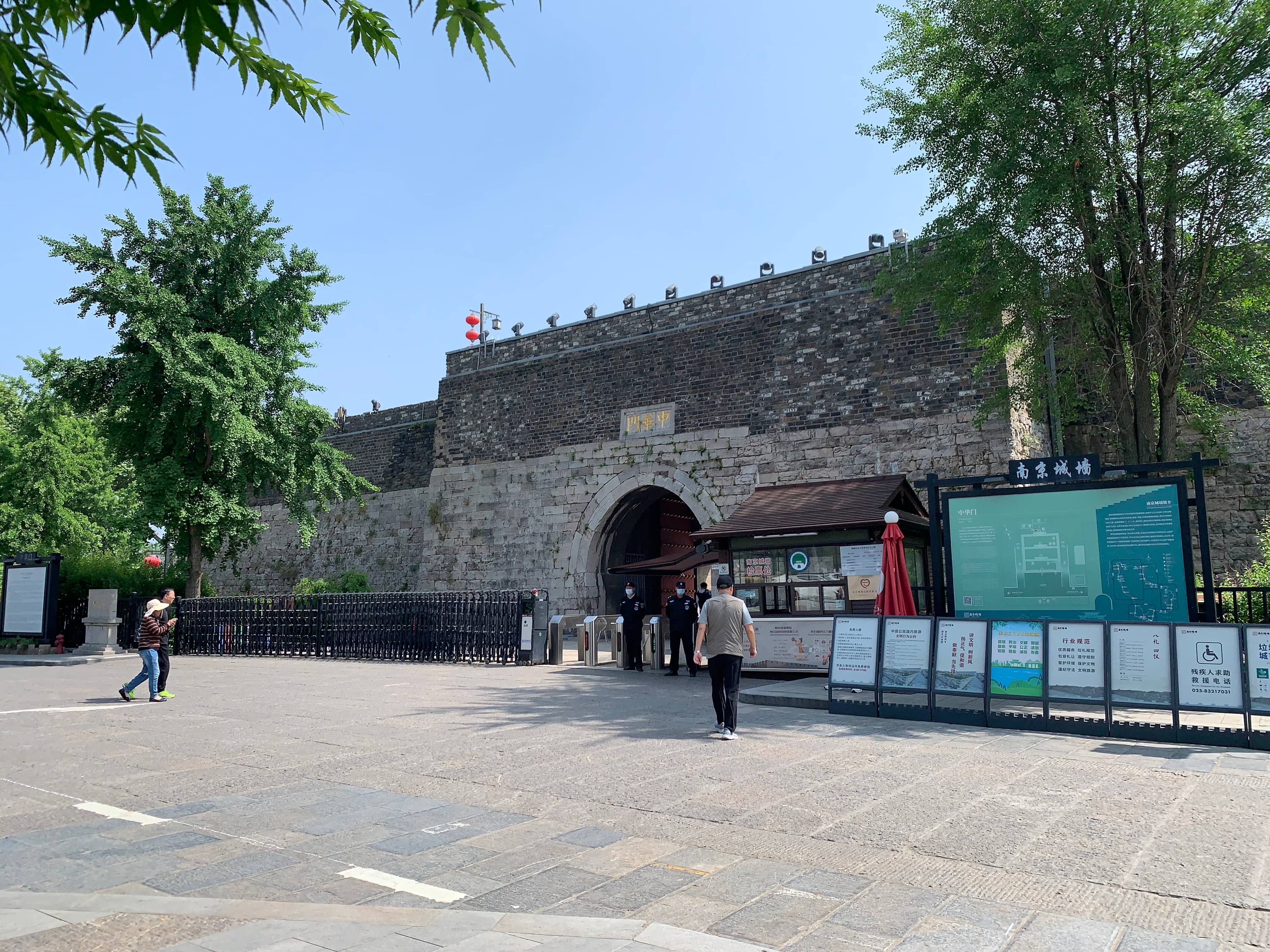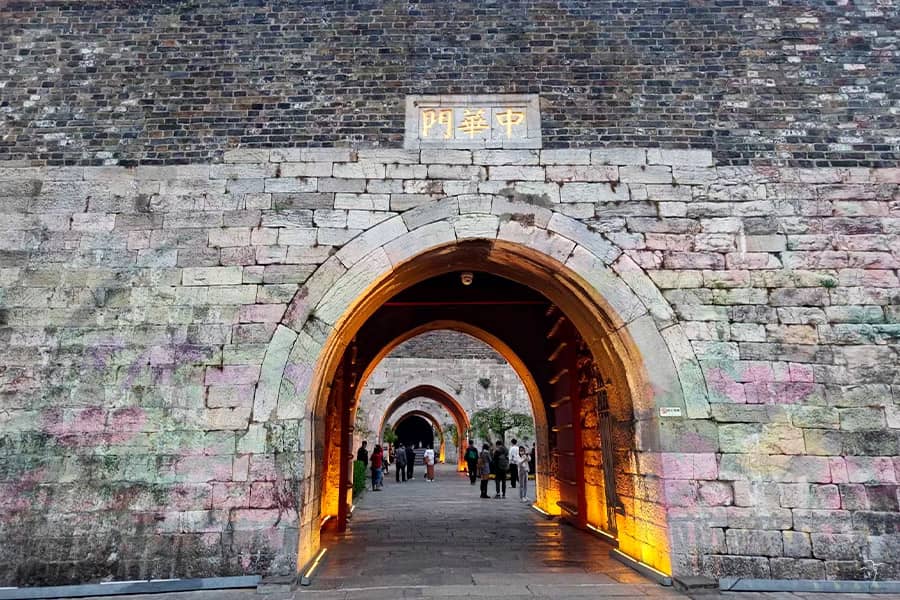Zhonghua Gate Nanjing
A monumental Ming Dynasty stone gate, Zhonghua Gate is a key part of Nanjing's ancient city wall, showcasing incredible defensive architecture.

Highlights
Must-see attractions

Social
From TikTok & Reddit
Best Time
Fewer crowds, better photos
Zhonghua Gate Nanjing
Best Time
Fewer crowds, better photos

Highlights
Must-see attractions
A monumental Ming Dynasty stone gate, Zhonghua Gate is a key part of Nanjing's ancient city wall, showcasing incredible defensive architecture.
"A worthwhile stop to glimpse old Nanjing, with a massive gate and impressive city wall views."
🎟️ Ticket Tip
While there's an entrance fee for the main gate, you can access parts of the wall for free through other gates.
👟 Comfortable Shoes Needed
You'll be doing a lot of walking and climbing stairs to explore the gate and walls.
Highlights
Discover the most iconic attractions and experiences

The Grand Zhonghua Gate
Main Gate Structure
A massive, ancient stone gate with intricate defensive architecture, a testament to Ming Dynasty engineering.

Wengcheng Defensive Chambers
Inside the Gate Complex
Explore the series of inner courtyards and chambers designed for defense, showcasing ingenious military strategy.

Nanjing City Wall Views
Top of the Gate and Walls
Ascend the gate and walk along sections of the ancient city wall for panoramic views of Nanjing.
Plans like a pro.
Thinks like you
Planning Your Visit
Timing is Key for a Better Experience
Understanding the Gate's Significance
Best Times
Insider Tips
from TikTok, Instagram & Reddit
🎟️ Ticket Tip
While there's an entrance fee for the main gate, you can access parts of the wall for free through other gates.
👟 Comfortable Shoes Needed
You'll be doing a lot of walking and climbing stairs to explore the gate and walls.
📚 History Exhibits
Displays are in both Chinese and English, offering insights into the gate's past and its role in history.
📸 Great Photo Ops
The sheer scale of the gate and the views from the wall make for stunning photographs.
Tips
from all over the internet
🎟️ Ticket Tip
While there's an entrance fee for the main gate, you can access parts of the wall for free through other gates.
👟 Comfortable Shoes Needed
You'll be doing a lot of walking and climbing stairs to explore the gate and walls.
📚 History Exhibits
Displays are in both Chinese and English, offering insights into the gate's past and its role in history.
📸 Great Photo Ops
The sheer scale of the gate and the views from the wall make for stunning photographs.
🚶♀️ Walk the Wall
Consider walking a section of the wall to experience its grandeur and connect with history.
What Travellers Say
Reviews Summary
Visitors praise Zhonghua Gate for its impressive historical architecture and the opportunity to walk along sections of the ancient city wall, offering great views. The bilingual displays are appreciated for providing historical context. However, some note that exhibits can be primarily in Chinese, and school groups can make it crowded at times.
"Nice historical place. Visited during opening so very few vistors yet. History of the wall and some details are displayed in both chinese and english so vistors can understand the history and function of the gate. Huge walls and offers a goood view of the city once you climbed the walls. You can walk the length of the wall if you like and exit on another point. Mini exhibits are available on some of the rooms but most display are in chinese."
John Lorenz Panotes
"East Gate city of Nanjing. Just go there and see for yourself. So many nice people. Enough places to eat and drink. Score souvenirs or have a walk into the wall. Current and ancient Nanjing in one place. Wonderful"
K. van der Horst
"There are few entrances of this Gate which is a miniture of the Great Wall of China. It surrounds the Xuanwu Lake, a popular tourist attraction. You can take a trolley bus to travel around the lake."
Grace Tsang
What People Like
What People Dislike
Frequently Asked Questions
🚇 🗺️ Getting There
Zhonghua Gate is accessible by public transport. You can take a bus or the metro to get close. Many visitors arrive via the metro system, with stations like Fuzimiao (Confucius Temple) being a convenient starting point for exploring the area and the gate.
Yes, Zhonghua Gate is adjacent to Xuanwu Lake, a popular tourist attraction. You can easily combine a visit to both. Consider taking a trolley bus around the lake after exploring the gate.
Depending on your starting point, walking might be an option, especially if you're exploring the Fuzimiao (Confucius Temple) area. However, Nanjing is a large city, so public transport is often more efficient for covering longer distances.
For exploring the extensive Nanjing City Wall, including Zhonghua Gate, walking is recommended for a full experience. For longer distances along the wall or to reach other attractions, consider local buses or the metro.
Several bus routes stop near Zhonghua Gate. It's advisable to check a local transit app or map upon arrival for the most up-to-date routes and schedules, as these can change.
🎫 🎫 Tickets & Entry
There is an entrance fee of approximately 28 Yuan for the main Zhonghua Gate. However, some parts of the Nanjing City Wall can be accessed for free by entering through other gates, though this might involve longer walks.
While the main gate complex has a fee, you can experience parts of the ancient city wall without charge by accessing it from different points. This often involves walking a longer distance to reach the gate itself.
Opening hours can vary, but generally, Zhonghua Gate and the surrounding city wall sections are open during daylight hours. It's best to check the latest official information before your visit, especially during holidays.
Information on online ticket purchasing might be available through local Chinese travel platforms or the official Nanjing tourism websites. It's recommended to check these in advance, especially if you prefer to book ahead.
The Nanjing City Wall Museum and the adjacent defensive constructions (Wengcheng) are often included with the Zhonghua Gate entrance fee, allowing visitors to experience the historical and cultural heritage.
🎫 🧭 Onsite Experience
Explore the massive stone gate, its intricate defensive chambers (Wengcheng), and climb sections of the ancient Nanjing City Wall for panoramic views. There are also historical displays and exhibits.
Yes, children can enjoy exploring the vastness of the gate and climbing the walls. However, ensure they are supervised due to the historical nature and potential for uneven surfaces.
A typical visit can take 1-3 hours, depending on how much of the wall you wish to walk and how thoroughly you explore the exhibits.
While official guided tours might not always be readily available in English, you can often find information boards with explanations in both Chinese and English. Local guides might be available for hire.
Zhonghua Gate is one of the most important gates of the Nanjing City Wall, built during the Ming Dynasty. It played a crucial defensive role and witnessed significant historical events, including the Nanjing Massacre.
🍽️ 🍽️ Food & Dining
Yes, there are dining options available near Zhonghua Gate, especially in the Fuzimiao (Confucius Temple) area. You can find various local eateries and food stalls offering Nanjing specialties.
Expect a range of Chinese cuisine, with a focus on Nanjing's local dishes. The Fuzimiao area is known for its bustling food scene, offering everything from street snacks to more formal dining experiences.
The Nanjing Impressions food halls, particularly the one near Fuzi Miao, are recommended for experiencing a variety of local dishes in a lively atmosphere.
Yes, the areas around Zhonghua Gate, especially the Fuzimiao district, are filled with shops selling souvenirs, traditional crafts, and local products.
The Fuzimiao area offers opportunities for traditional dining, sometimes with cultural performances or in settings that evoke historical ambiance.
📸 📸 Photography
Capture the grandeur of the main gate, the intricate details of the Wengcheng chambers, and the panoramic city views from the top of the walls. Early morning light is excellent for photography.
Photography is generally allowed inside Zhonghua Gate and on the city walls. However, always be mindful of any specific signage or restrictions in certain exhibit areas.
Early mornings offer fewer crowds and softer light, ideal for capturing the scale and details. Late afternoons can provide beautiful golden hour lighting for cityscapes.
Look for opportunities to photograph the imposing architecture, the vastness of the defensive chambers, and the contrast between the ancient walls and the modern city skyline. Seasonal decorations, like Spring Festival couplets, also offer unique shots.
Drone photography is typically restricted in and around historical sites and urban areas in China. It's best to assume it's not permitted unless explicitly stated otherwise by local authorities.
For Different Travelers
Tailored advice for your travel style
👨👩👧 Families with Kids
While exhibits might be primarily in Chinese, the visual aspects of the gate and the expansive views are universally engaging. Consider bringing snacks and water, especially on warmer days. The nearby Fuzimiao area also offers family-friendly dining and entertainment options to round off your visit.
🚶 Budget Travelers
Pack your own snacks and water to save on expenses. Exploring the surrounding Fuzimiao area can also be done on a budget, with many street food options and affordable souvenirs. Prioritize walking and using public transport to minimize travel costs.
🏛️ History Buffs
Take your time to read the bilingual displays and appreciate the engineering marvels. Consider researching the history of the Nanjing City Wall beforehand to enhance your understanding. The gate offers a tangible connection to the past, allowing you to walk in the footsteps of those who defended and lived within its formidable walls.
Deep Dives
In-depth insights and expert knowledge
The Historical Significance of Zhonghua Gate
The gate's historical importance is deeply intertwined with the tragic events of the Second Sino-Japanese War. During the 1937 Nanjing Massacre, the gate and the surrounding city walls bore witness to immense suffering and destruction. The gate's original massive wooden structure, which had stood for centuries, was destroyed during this period. Today, the gate serves not only as a historical monument but also as a solemn memorial, with exhibits detailing its past and the atrocities committed.
Visiting Zhonghua Gate offers a tangible connection to China's past. The scale of the structure is awe-inspiring, and walking along the preserved sections of the city wall provides a unique perspective on Nanjing's historical defenses and its urban landscape. The exhibits within the gate complex, though sometimes primarily in Chinese, offer valuable insights into its construction, military function, and its role in pivotal historical moments.
Exploring the Nanjing City Wall
The wall's construction involved immense labor and sophisticated techniques for its era. It was designed to protect the capital city of the Ming Dynasty. Today, visitors can access various parts of the wall, with Zhonghua Gate being one of the most prominent and well-preserved sections. Walking along the wall provides not only a sense of scale but also offers excellent vantage points for observing the city and its surroundings.
When exploring the Nanjing City Wall, remember that different sections may have varying accessibility and entrance fees. Zhonghua Gate itself has a fee, but other access points might be free, allowing for a more budget-friendly experience if you're willing to walk further. The experience of traversing these ancient ramparts is a highlight for many visitors, offering a unique blend of history, architecture, and scenic views.
Architectural Marvels of Zhonghua Gate
These Wengcheng were designed to trap any enemy forces that managed to breach the outer gates. Soldiers could then attack from multiple angles, making it a formidable obstacle. The gate also features numerous smaller gates and passages, further enhancing its defensive capabilities. The sheer scale of the stone construction and the precision of its assembly are testaments to the advanced engineering skills of the Ming Dynasty.
Inside the gate, visitors can explore some of these chambers and learn about the gate's original structure, including the massive wooden gate that was tragically destroyed during wartime. The architectural details, from the archways to the ramparts, offer a fascinating glimpse into ancient military fortifications. The gate's enduring presence is a powerful symbol of Nanjing's historical resilience and architectural prowess.

Social
from TikTok, Instagram & Reddit